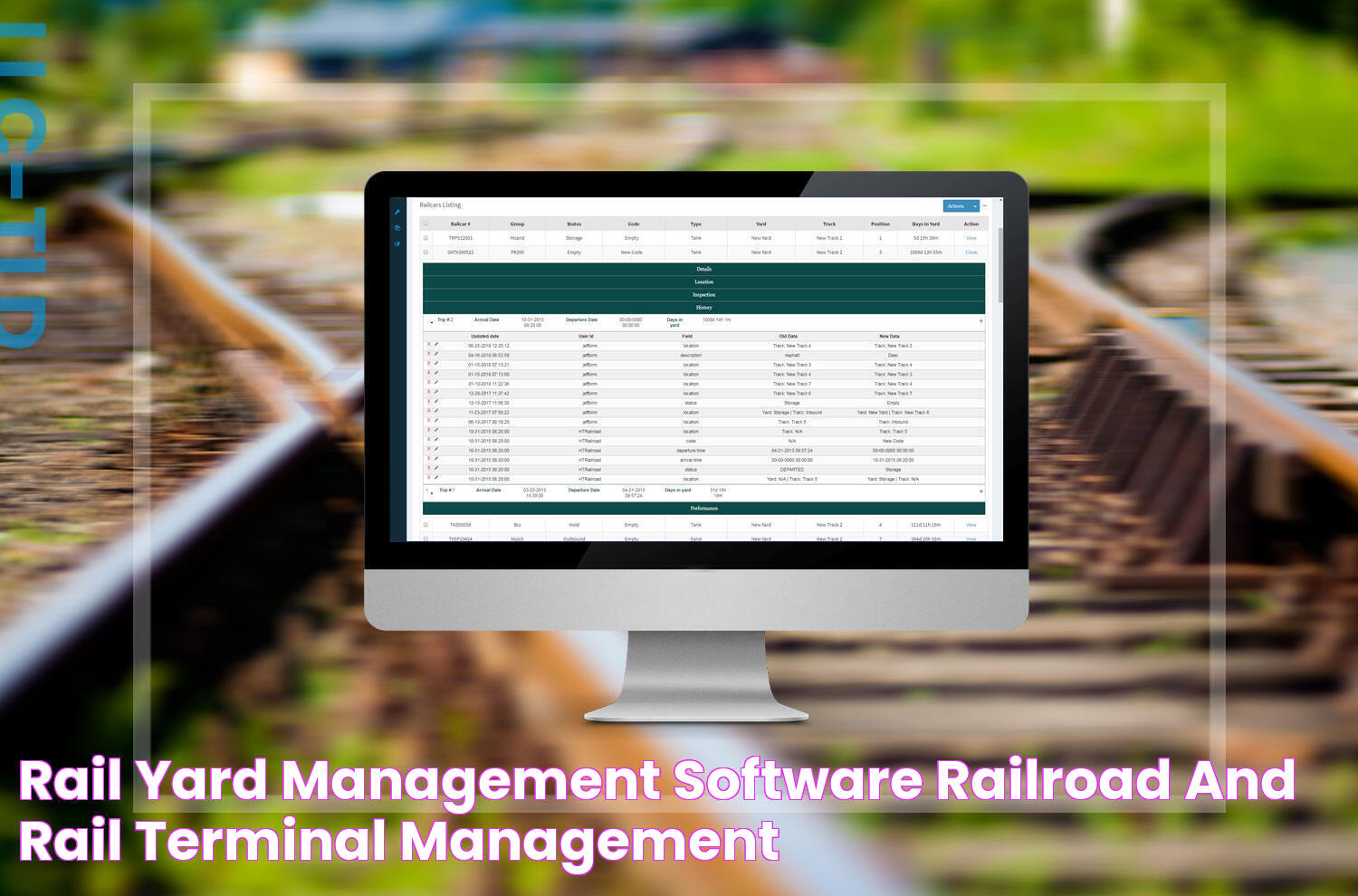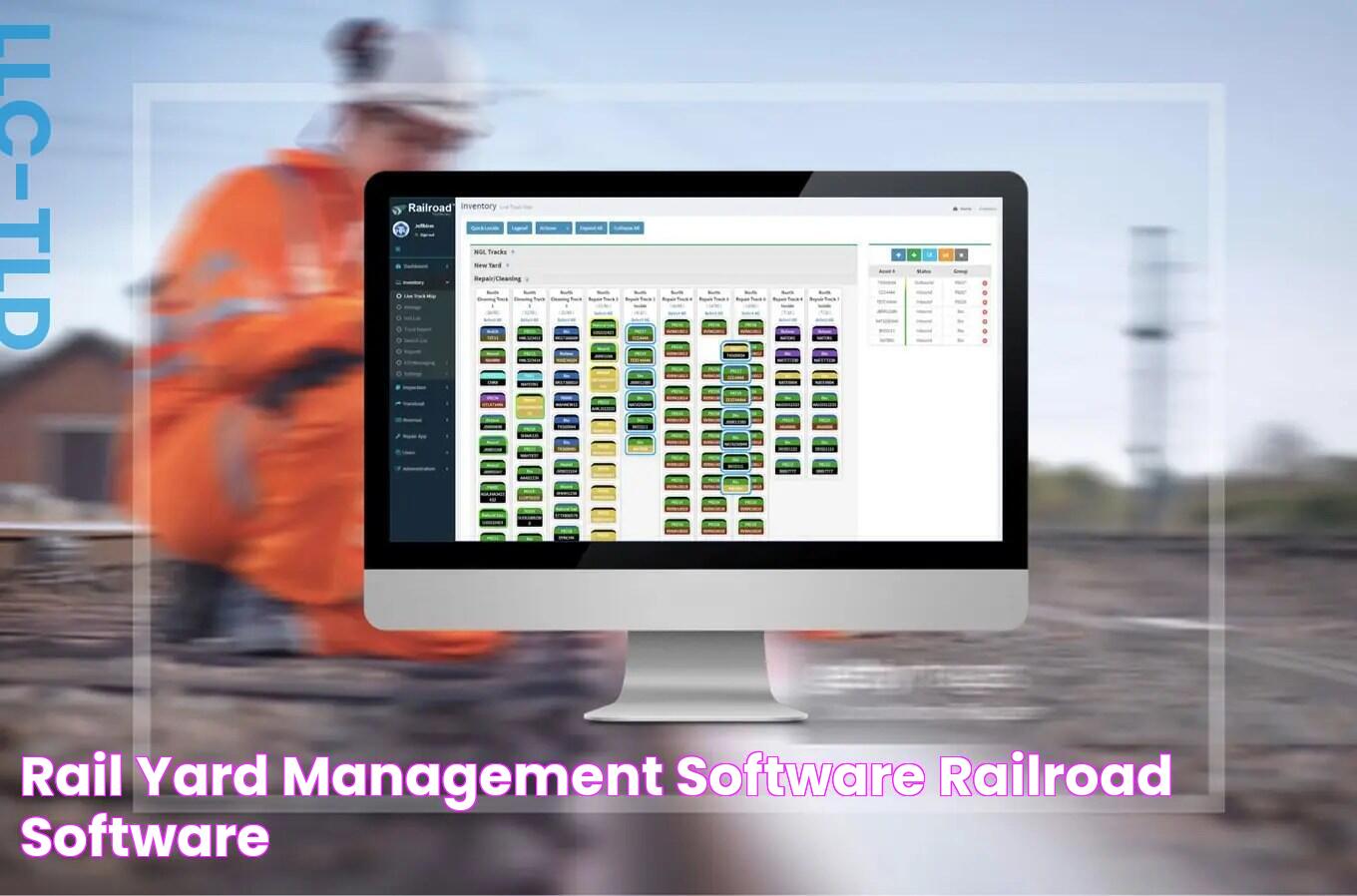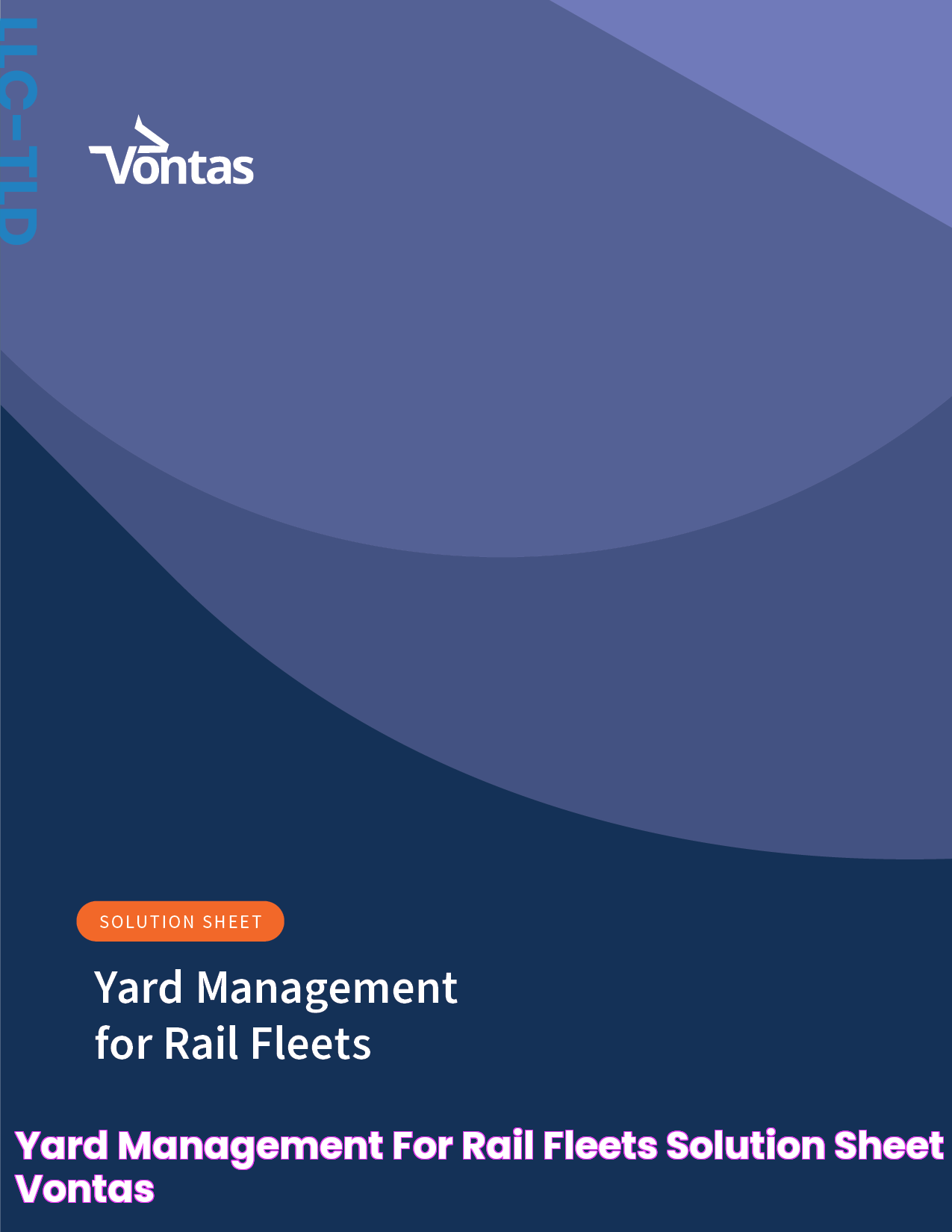Revolutionize Rail Yard Management: Unlock Efficiency And Productivity
Rail yard management is the process of planning, organizing, and directing the movement of trains and rail cars within a rail yard.
Rail yards are essential to the efficient operation of a railroad network. They provide a place for trains to be assembled, disassembled, and serviced. Rail yards also serve as a staging area for freight cars, which are stored until they are needed for transport.
Rail yard management is a complex and challenging task. Rail yard managers must be able to coordinate the movement of trains and rail cars in a safe and efficient manner. They must also be able to respond to unexpected events, such as delays or derailments.
Read also:Indulge In The Distinct Flavor Discover The Unique Taste Of Target Keyword
Rail Yard Management
Rail yard management encompasses various key aspects crucial for efficient railroad operations. These include:
- Planning: Developing strategies for efficient train and rail car movement.
- Organization: Establishing clear processes and procedures for yard operations.
- Coordination: Managing the movement of trains and rail cars to minimize delays and maximize throughput.
- Safety: Ensuring adherence to safety regulations and implementing measures to prevent accidents.
- Communication: Facilitating effective communication among yard personnel and external stakeholders.
- Technology: Utilizing advanced technologies to optimize yard operations.
These aspects are interconnected and essential for the smooth functioning of rail yards. For instance, effective planning helps minimize congestion and delays, while robust communication ensures timely and accurate information exchange among yard personnel. Additionally, leveraging technology, such as automated yard management systems, can enhance efficiency and safety by providing real-time visibility and control over yard operations.
1. Planning
Planning is a critical component of rail yard management, as it lays the foundation for efficient train and rail car movement. Effective planning involves developing strategies that optimize the utilization of yard resources, such as tracks, locomotives, and personnel. By carefully planning the movement of trains and rail cars, yard managers can minimize delays, reduce congestion, and improve overall yard throughput.
One key aspect of planning is the creation of yard maps and schedules. Yard maps provide a visual representation of the yard layout, including tracks, switches, and other infrastructure. Schedules outline the planned arrival and departure times of trains and rail cars, as well as the specific tracks they will occupy. By carefully planning the use of yard resources, managers can avoid conflicts and ensure the smooth flow of traffic.
Another important aspect of planning is the management of train and rail car inventory. Yard managers must have real-time visibility into the location and status of all trains and rail cars in the yard. This information allows them to make informed decisions about how to best utilize yard resources and minimize empty miles. Advanced technologies, such as yard management systems, can provide real-time tracking and inventory management capabilities, enabling managers to optimize yard operations and improve efficiency.
Effective planning is essential for the efficient operation of any rail yard. By carefully planning the movement of trains and rail cars, yard managers can improve throughput, reduce delays, and ensure the safe and efficient operation of the yard.
Read also:The Extraordinary Net Worth Of Kendra G Exploring Her Financial Success
2. Organization
Organization is a critical component of rail yard management, as it provides a framework for efficient and safe yard operations. Clear processes and procedures help ensure that all yard personnel are aware of their roles and responsibilities and that operations are conducted in a consistent and standardized manner. This reduces the risk of errors and accidents and helps to improve overall yard efficiency.
Key aspects of organization in rail yard management include:
- Developing and documenting standard operating procedures (SOPs) for all yard operations, including train and rail car movement, switching, and maintenance.
- Establishing clear lines of communication and reporting relationships among yard personnel.
- Providing training to all yard personnel on SOPs and safety regulations.
- Implementing a system for tracking and monitoring yard operations to identify areas for improvement.
By establishing clear processes and procedures, rail yard managers can improve safety, efficiency, and compliance. Well-organized yards are able to handle a higher volume of traffic with fewer delays and accidents. This can lead to significant cost savings and improved customer satisfaction.
For example, one rail yard implemented a new SOP for train arrivals and departures. The new SOP clearly defined the roles and responsibilities of all yard personnel involved in the process, from the trainmaster to the switchmen. This led to a significant reduction in delays and improved safety.
Another rail yard implemented a new system for tracking and monitoring yard operations. The new system provided real-time visibility into all yard activities, including train movements, car placements, and maintenance. This information yard managers to identify areas for improvement and make necessary adjustments to operations.
These are just two examples of how clear processes and procedures can improve rail yard management. By taking the time to develop and implement effective SOPs, rail yards can improve safety, efficiency, and compliance.
3. Coordination
Coordination is a critical component of rail yard management, as it directly impacts the efficiency and productivity of yard operations. Effective coordination ensures that trains and rail cars are moved through the yard in a smooth and timely manner, minimizing delays and maximizing throughput. This, in turn, leads to improved customer service, reduced costs, and increased safety.
Key aspects of coordination in rail yard management include:
- Developing and implementing clear operating procedures for all yard activities, including train arrivals and departures, switching, and car placement.
- Establishing effective communication channels among all yard personnel, including train crews, switchmen, and yardmasters.
- Utilizing real-time tracking and monitoring systems to provide visibility into yard operations and identify potential bottlenecks.
- Coordinating with external stakeholders, such as railroads and customers, to ensure smooth handoffs and minimize delays.
By effectively coordinating the movement of trains and rail cars, rail yards can improve their overall performance and achieve a number of benefits, including:
- Reduced train dwell time
- Improved car utilization
- Increased throughput
- Enhanced safety
- Reduced costs
For example, one rail yard implemented a new coordination system that utilized real-time tracking and monitoring technology. This system provided yardmasters with a comprehensive view of all yard activities, enabling them to identify and address potential bottlenecks before they caused delays. As a result, the yard was able to reduce train dwell time by 15% and increase throughput by 10%.
Another rail yard implemented a new operating procedure for train arrivals and departures. The new procedure clearly defined the roles and responsibilities of all yard personnel involved in the process, from the trainmaster to the switchmen. This led to a significant reduction in delays and improved safety.
These are just two examples of how effective coordination can improve rail yard management. By taking the time to develop and implement effective coordination strategies, rail yards can improve their efficiency, productivity, and safety.
4. Safety
Safety is a critical component of rail yard management, as it directly impacts the well-being of employees, the protection of property, and the overall efficiency of yard operations. Adhering to safety regulations and implementing effective accident prevention measures is essential for creating a safe and productive work environment.
Key aspects of safety in rail yard management include:
- Developing and implementing comprehensive safety policies and procedures.
- Providing regular safety training to all yard personnel.
- Conducting regular safety audits and inspections.
- Enforcing safety regulations and disciplining employees who violate safety rules.
- Working with external stakeholders, such as railroads and contractors, to ensure that they adhere to safety standards.
By effectively managing safety, rail yards can prevent accidents, reduce injuries and fatalities, and create a more productive work environment. This, in turn, leads to reduced costs, improved employee morale, and enhanced customer satisfaction.
For example, one rail yard implemented a new safety program that included comprehensive safety training for all employees, regular safety audits, and a system for reporting and investigating near misses. As a result, the yard was able to reduce its accident rate by 20% and improve its overall safety performance.
Another rail yard implemented a new safety procedure for switching operations. The new procedure required all switchmen to use hand signals and maintain clear communication with each other. This led to a significant reduction in switching accidents and improved the overall safety of yard operations.
These are just two examples of how effective safety management can improve rail yard operations. By taking the time to develop and implement comprehensive safety programs, rail yards can create a safer and more productive work environment for their employees.5. Communication
Effective communication is essential for the safe and efficient operation of any rail yard. Yard personnel must be able to communicate clearly and concisely with each other, as well as with external stakeholders such as railroads, customers, and contractors. This communication helps to ensure that trains and rail cars are moved through the yard in a timely and orderly manner, and that all safety regulations are followed.
There are a number of different communication channels that can be used in a rail yard, including radios, telephones, hand signals, and written instructions. It is important to have a clear communication plan in place that outlines which channels should be used for different types of communication. For example, radios may be used for general communication between yard personnel, while telephones may be used for more formal communication with external stakeholders.
In addition to having a clear communication plan, it is also important to provide training to all yard personnel on effective communication skills. This training should cover topics such as how to use different communication channels, how to communicate clearly and concisely, and how to handle difficult conversations.
Effective communication is essential for the safe and efficient operation of any rail yard. By implementing a clear communication plan and providing training to all yard personnel on effective communication skills, rail yards can improve safety, efficiency, and customer satisfaction.
6. Technology
Technology plays a vital role in modern rail yard management. Advanced technologies can be used to improve safety, efficiency, and productivity in a number of ways. For example, yard management systems (YMS) can be used to track the location and status of trains and rail cars in real time. This information can be used to optimize train movements, reduce delays, and improve overall yard efficiency. Other technologies, such as automated switching systems and remote control locomotives, can also be used to improve safety and efficiency in rail yards.
One of the most important ways that technology can be used to optimize yard operations is by improving visibility. YMSs provide yard managers with a real-time view of all yard activities, including train movements, car placements, and maintenance. This information can be used to identify potential bottlenecks and make necessary adjustments to operations. For example, if a YMS identifies that a particular track is congested, the yard manager can reroute trains to avoid delays.
Technology can also be used to improve communication in rail yards. Radios, telephones, and other communication systems can be used to keep yard personnel informed of changing conditions and to coordinate activities. This can help to prevent accidents and improve overall yard efficiency.
The use of advanced technologies in rail yard management is essential for improving safety, efficiency, and productivity. By investing in technology, rail yards can improve their overall performance and achieve a number of benefits, including:
- Reduced train dwell time
- Improved car utilization
- Increased throughput
- Enhanced safety
- Reduced costs
As technology continues to develop, we can expect to see even more innovative ways to use technology to optimize rail yard operations. This will lead to even greater improvements in safety, efficiency, and productivity.
Frequently Asked Questions About Rail Yard Management
Rail yard management is a complex and challenging task. Rail yard managers must be able to coordinate the movement of trains and rail cars in a safe and efficient manner. They must also be able to respond to unexpected events, such as delays or derailments.
Here are some frequently asked questions about rail yard management:
Question 1: What is the most important aspect of rail yard management?
The most important aspect of rail yard management is safety. Rail yards are inherently dangerous places, with trains and rail cars moving at high speeds. Rail yard managers must take all necessary precautions to ensure the safety of their employees and the public.
Question 2: What are the biggest challenges facing rail yard managers?
The biggest challenges facing rail yard managers are congestion and delays. Rail yards are often located in densely populated areas, and they can become congested with trains and rail cars waiting to be moved. This can lead to delays, which can be costly for railroads and their customers.
Question 3: What are the latest technologies being used to improve rail yard management?
The latest technologies being used to improve rail yard management include yard management systems (YMS) and automated switching systems. YMSs provide rail yard managers with a real-time view of all yard activities, including train movements, car placements, and maintenance. Automated switching systems can be used to move trains and rail cars without the need for human intervention.
Question 4: What are the benefits of using advanced technologies in rail yard management?
The benefits of using advanced technologies in rail yard management include improved safety, efficiency, and productivity. YMSs can help to prevent accidents by providing rail yard managers with a real-time view of all yard activities. Automated switching systems can improve efficiency by moving trains and rail cars without the need for human intervention.
Question 5: What is the future of rail yard management?
The future of rail yard management is bright. As technology continues to develop, we can expect to see even more innovative ways to improve safety, efficiency, and productivity in rail yards.
Question 6: Where can I learn more about rail yard management?
There are a number of resources available to learn more about rail yard management. The Association of American Railroads (AAR) offers a number of training courses on rail yard management. You can also find a number of books and articles on rail yard management online.
Rail yard management is a complex and challenging task, but it is also an essential part of the railroad industry. By understanding the challenges and opportunities facing rail yard managers, we can help to ensure the safe and efficient movement of goods and people by rail.
Transition to the next article section
Rail Yard Management Tips
Rail yard management is a complex and challenging task. Rail yard managers must be able to coordinate the movement of trains and rail cars in a safe and efficient manner. They must also be able to respond to unexpected events, such as delays or derailments.
Here are five tips to help rail yard managers improve safety, efficiency, and productivity:
Tip 1: Implement a yard management system (YMS).A YMS is a software system that helps rail yard managers track the location and status of trains and rail cars in real time. This information can be used to optimize train movements, reduce delays, and improve overall yard efficiency.
Tip 2: Use automated switching systems.Automated switching systems can be used to move trains and rail cars without the need for human intervention. This can improve safety and efficiency by reducing the risk of accidents and freeing up rail yard personnel to focus on other tasks.
Tip 3: Train yard personnel on safety procedures.Rail yards are inherently dangerous places, so it is important to ensure that all yard personnel are properly trained on safety procedures. This training should cover topics such as how to safely move trains and rail cars, how to respond to emergencies, and how to use safety equipment.
Tip 4: Regularly inspect and maintain yard equipment.Regularly inspecting and maintaining yard equipment is essential for preventing accidents and ensuring the smooth operation of the yard. This includes inspecting tracks, switches, locomotives, and rail cars. Any defects or damage should be repaired immediately.
Tip 5: Communicate effectively.Effective communication is essential for the safe and efficient operation of any rail yard. Rail yard managers must be able to communicate clearly and concisely with their staff, as well as with external stakeholders such as railroads and customers.
By following these tips, rail yard managers can improve safety, efficiency, and productivity in their yards.
Transition to the article's conclusion
Rail Yard Management
Rail yard management is a critical component of the railroad industry. Rail yards are responsible for the safe and efficient movement of trains and rail cars, and they play a vital role in the transportation of goods and people. Rail yard managers must be able to coordinate the movement of trains and rail cars in a safe and efficient manner, and they must be able to respond to unexpected events, such as delays or derailments.
There are a number of challenges facing rail yard managers, including congestion, delays, and safety concerns. However, there are also a number of opportunities to improve rail yard management. By implementing advanced technologies, such as yard management systems and automated switching systems, rail yard managers can improve safety, efficiency, and productivity. Additionally, by training yard personnel on safety procedures and regularly inspecting and maintaining yard equipment, rail yard managers can help to prevent accidents and ensure the smooth operation of the yard.
Rail yard management is a complex and challenging task, but it is also an essential part of the railroad industry. By understanding the challenges and opportunities facing rail yard managers, we can help to ensure the safe and efficient movement of goods and people by rail.
Connie Snyder: Renowned Expert In Health And Fitness
When Did Mielle Organics Sell Their Company: The Full Story
Charlotte Tilbury Makeup: The Ultimate Guide For Mature Skin


